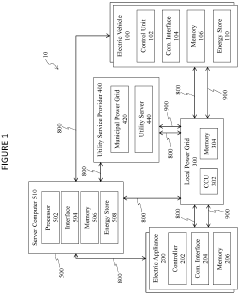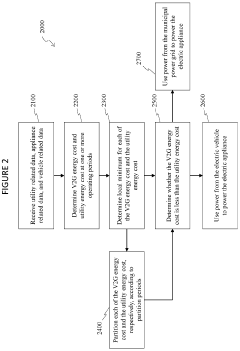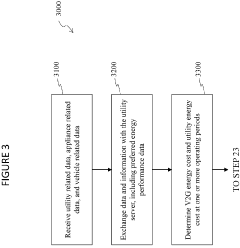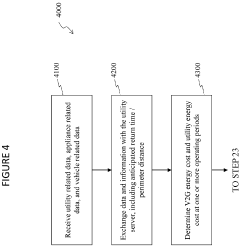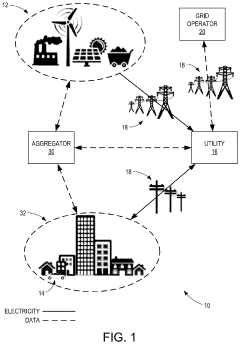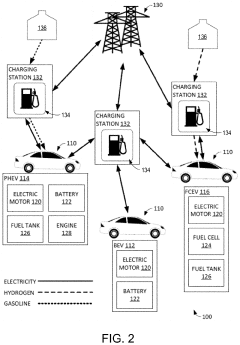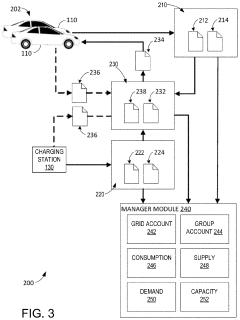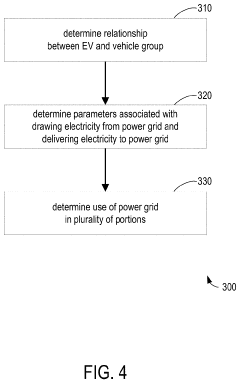Vehicle-to-Grid: Connecting Electric Vehicles with Solar Grids
SEP 23, 20259 MIN READ
Generate Your Research Report Instantly with AI Agent
Patsnap Eureka helps you evaluate technical feasibility & market potential.
V2G Technology Background and Objectives
Vehicle-to-Grid (V2G) technology represents a transformative approach to energy management that has evolved significantly over the past decade. The concept emerged in the late 1990s when Dr. Willett Kempton and his team at the University of Delaware first proposed using electric vehicle (EV) batteries as distributed energy resources. Since then, V2G has progressed from theoretical concept to practical implementation, driven by the convergence of renewable energy adoption, smart grid development, and electric vehicle proliferation.
The fundamental principle of V2G technology involves bidirectional power flow between electric vehicles and the electrical grid. This enables EVs to not only consume electricity for transportation but also serve as mobile energy storage units that can discharge power back to the grid when needed. The integration with solar grids represents a particularly promising application, as it addresses the intermittency challenges inherent in solar power generation.
Technical evolution in this field has accelerated dramatically since 2015, with significant advancements in bidirectional charging hardware, communication protocols, and grid integration standards. The development of ISO 15118 and CHAdeMO protocols has been instrumental in establishing the technical foundation for V2G implementations. Concurrently, battery management systems have evolved to accommodate the additional cycling demands imposed by grid services without compromising vehicle battery longevity.
The primary technical objectives of V2G solar grid integration encompass several dimensions. First, enhancing grid stability by utilizing EV batteries to absorb excess solar generation during peak production periods and releasing stored energy during evening demand spikes. Second, optimizing local energy consumption by prioritizing self-consumption of solar-generated electricity within microgrids before exporting to the main grid. Third, developing sophisticated energy management systems capable of predicting both vehicle usage patterns and solar generation forecasts to maximize system efficiency.
Looking forward, V2G technology aims to achieve seamless integration with smart grid infrastructure, enabling automated participation in energy markets through aggregation platforms. The ultimate goal is to create a resilient, decentralized energy ecosystem where millions of electric vehicles serve as flexible grid assets, facilitating higher penetration of variable renewable energy sources while providing economic benefits to vehicle owners and grid operators alike.
The fundamental principle of V2G technology involves bidirectional power flow between electric vehicles and the electrical grid. This enables EVs to not only consume electricity for transportation but also serve as mobile energy storage units that can discharge power back to the grid when needed. The integration with solar grids represents a particularly promising application, as it addresses the intermittency challenges inherent in solar power generation.
Technical evolution in this field has accelerated dramatically since 2015, with significant advancements in bidirectional charging hardware, communication protocols, and grid integration standards. The development of ISO 15118 and CHAdeMO protocols has been instrumental in establishing the technical foundation for V2G implementations. Concurrently, battery management systems have evolved to accommodate the additional cycling demands imposed by grid services without compromising vehicle battery longevity.
The primary technical objectives of V2G solar grid integration encompass several dimensions. First, enhancing grid stability by utilizing EV batteries to absorb excess solar generation during peak production periods and releasing stored energy during evening demand spikes. Second, optimizing local energy consumption by prioritizing self-consumption of solar-generated electricity within microgrids before exporting to the main grid. Third, developing sophisticated energy management systems capable of predicting both vehicle usage patterns and solar generation forecasts to maximize system efficiency.
Looking forward, V2G technology aims to achieve seamless integration with smart grid infrastructure, enabling automated participation in energy markets through aggregation platforms. The ultimate goal is to create a resilient, decentralized energy ecosystem where millions of electric vehicles serve as flexible grid assets, facilitating higher penetration of variable renewable energy sources while providing economic benefits to vehicle owners and grid operators alike.
Market Analysis for V2G Integration
The Vehicle-to-Grid (V2G) market is experiencing significant growth as the integration of electric vehicles with solar grids gains traction globally. Current market analysis indicates that the V2G technology market was valued at approximately $1.8 billion in 2022, with projections suggesting a compound annual growth rate of 27% through 2030. This remarkable growth trajectory is primarily driven by increasing electric vehicle adoption rates, expanding renewable energy infrastructure, and supportive government policies worldwide.
Consumer demand for V2G integration is predominantly concentrated in regions with high electric vehicle penetration and advanced grid infrastructure. North America, Europe, and parts of Asia-Pacific currently represent the largest market segments. The European market shows particular promise due to aggressive carbon reduction targets and substantial investments in smart grid technologies. Countries like Denmark, Netherlands, and the United Kingdom are pioneering V2G pilot programs that demonstrate strong consumer interest and utility engagement.
Market segmentation reveals distinct customer profiles for V2G technology. Early adopters typically include environmentally conscious consumers with solar installations, fleet operators seeking to optimize charging costs, and energy-focused businesses exploring new revenue streams through grid services. Commercial fleet operators represent a particularly promising segment, as they can achieve significant operational cost reductions through optimized charging schedules and energy trading capabilities.
The value proposition of V2G integration with solar grids centers on three key benefits: cost reduction through optimized charging during periods of solar abundance, revenue generation through grid services, and enhanced energy resilience. Market research indicates that consumers are increasingly willing to participate in V2G programs when presented with clear financial incentives and minimal impact on vehicle availability.
Pricing models in the V2G market are still evolving, with several approaches gaining traction. These include service-based subscription models, revenue-sharing arrangements between vehicle owners and utilities, and upfront hardware purchases with ongoing service fees. The most successful models appear to be those that minimize initial investment while providing transparent financial benefits to vehicle owners.
Market barriers include concerns about battery degradation, limited compatible vehicle models, complex regulatory frameworks, and insufficient consumer awareness. However, these barriers are gradually diminishing as technology advances, more automakers incorporate bidirectional charging capabilities, and regulatory frameworks mature to accommodate grid-interactive vehicles.
Consumer demand for V2G integration is predominantly concentrated in regions with high electric vehicle penetration and advanced grid infrastructure. North America, Europe, and parts of Asia-Pacific currently represent the largest market segments. The European market shows particular promise due to aggressive carbon reduction targets and substantial investments in smart grid technologies. Countries like Denmark, Netherlands, and the United Kingdom are pioneering V2G pilot programs that demonstrate strong consumer interest and utility engagement.
Market segmentation reveals distinct customer profiles for V2G technology. Early adopters typically include environmentally conscious consumers with solar installations, fleet operators seeking to optimize charging costs, and energy-focused businesses exploring new revenue streams through grid services. Commercial fleet operators represent a particularly promising segment, as they can achieve significant operational cost reductions through optimized charging schedules and energy trading capabilities.
The value proposition of V2G integration with solar grids centers on three key benefits: cost reduction through optimized charging during periods of solar abundance, revenue generation through grid services, and enhanced energy resilience. Market research indicates that consumers are increasingly willing to participate in V2G programs when presented with clear financial incentives and minimal impact on vehicle availability.
Pricing models in the V2G market are still evolving, with several approaches gaining traction. These include service-based subscription models, revenue-sharing arrangements between vehicle owners and utilities, and upfront hardware purchases with ongoing service fees. The most successful models appear to be those that minimize initial investment while providing transparent financial benefits to vehicle owners.
Market barriers include concerns about battery degradation, limited compatible vehicle models, complex regulatory frameworks, and insufficient consumer awareness. However, these barriers are gradually diminishing as technology advances, more automakers incorporate bidirectional charging capabilities, and regulatory frameworks mature to accommodate grid-interactive vehicles.
V2G-Solar Grid Technical Challenges
The integration of Vehicle-to-Grid (V2G) technology with solar grid systems presents several significant technical challenges that must be addressed for successful implementation. These challenges span multiple domains including power electronics, communication systems, battery management, and grid infrastructure compatibility.
Power flow management represents one of the most critical challenges in V2G-solar grid integration. Bidirectional power converters must handle variable solar generation patterns while simultaneously managing vehicle charging and discharging cycles. Current converter technologies often struggle with efficiency losses during these bidirectional transfers, typically achieving only 85-90% round-trip efficiency, which impacts overall system economics.
Communication protocols present another substantial hurdle. The seamless coordination between electric vehicles (EVs), charging infrastructure, and solar grid systems requires robust, standardized communication frameworks. Existing protocols like ISO 15118, OpenADR, and OCPP (Open Charge Point Protocol) provide partial solutions but lack comprehensive integration capabilities across all system components, creating interoperability issues.
Battery degradation concerns significantly impact V2G-solar grid implementation. The additional charge-discharge cycles imposed by V2G operations can accelerate battery wear, potentially reducing EV battery lifespan by 10-15% depending on usage patterns. This degradation must be carefully managed through advanced battery management systems that can optimize cycling based on battery chemistry, state of charge, and thermal conditions.
Grid stability and power quality issues emerge when large numbers of EVs connect to solar-powered grids. Voltage fluctuations, frequency deviations, and harmonic distortions can occur due to the intermittent nature of both solar generation and EV charging/discharging patterns. These disturbances require sophisticated grid management systems capable of real-time monitoring and response.
Cybersecurity vulnerabilities increase exponentially with the integration of V2G and solar grid systems. The numerous digital communication points between vehicles, charging infrastructure, and grid management systems create potential attack vectors that could compromise grid stability or vehicle functionality. Current security protocols often fail to address the unique challenges of this integrated environment.
Regulatory and standardization gaps further complicate implementation. Many regions lack clear regulatory frameworks for V2G participation in energy markets, grid services compensation, and technical standards for equipment certification. This regulatory uncertainty impedes investment and slows technological advancement in the field.
Cost barriers remain significant, with specialized bidirectional charging equipment typically costing 2-3 times more than standard unidirectional chargers. Additionally, the advanced metering infrastructure and control systems required for V2G-solar integration represent substantial capital investments for utilities and charging network operators.
Power flow management represents one of the most critical challenges in V2G-solar grid integration. Bidirectional power converters must handle variable solar generation patterns while simultaneously managing vehicle charging and discharging cycles. Current converter technologies often struggle with efficiency losses during these bidirectional transfers, typically achieving only 85-90% round-trip efficiency, which impacts overall system economics.
Communication protocols present another substantial hurdle. The seamless coordination between electric vehicles (EVs), charging infrastructure, and solar grid systems requires robust, standardized communication frameworks. Existing protocols like ISO 15118, OpenADR, and OCPP (Open Charge Point Protocol) provide partial solutions but lack comprehensive integration capabilities across all system components, creating interoperability issues.
Battery degradation concerns significantly impact V2G-solar grid implementation. The additional charge-discharge cycles imposed by V2G operations can accelerate battery wear, potentially reducing EV battery lifespan by 10-15% depending on usage patterns. This degradation must be carefully managed through advanced battery management systems that can optimize cycling based on battery chemistry, state of charge, and thermal conditions.
Grid stability and power quality issues emerge when large numbers of EVs connect to solar-powered grids. Voltage fluctuations, frequency deviations, and harmonic distortions can occur due to the intermittent nature of both solar generation and EV charging/discharging patterns. These disturbances require sophisticated grid management systems capable of real-time monitoring and response.
Cybersecurity vulnerabilities increase exponentially with the integration of V2G and solar grid systems. The numerous digital communication points between vehicles, charging infrastructure, and grid management systems create potential attack vectors that could compromise grid stability or vehicle functionality. Current security protocols often fail to address the unique challenges of this integrated environment.
Regulatory and standardization gaps further complicate implementation. Many regions lack clear regulatory frameworks for V2G participation in energy markets, grid services compensation, and technical standards for equipment certification. This regulatory uncertainty impedes investment and slows technological advancement in the field.
Cost barriers remain significant, with specialized bidirectional charging equipment typically costing 2-3 times more than standard unidirectional chargers. Additionally, the advanced metering infrastructure and control systems required for V2G-solar integration represent substantial capital investments for utilities and charging network operators.
Current V2G-Solar Grid Solutions
01 V2G connection infrastructure and protocols
Vehicle-to-Grid technology requires specialized infrastructure and communication protocols to enable bidirectional power flow between electric vehicles and the power grid. This includes charging stations with bidirectional capabilities, grid interface controllers, and standardized communication protocols that allow vehicles to respond to grid signals. These systems enable EVs to not only draw power from the grid but also feed power back when needed, supporting grid stability and providing services such as frequency regulation.- V2G connection infrastructure and protocols: Vehicle-to-Grid technology requires specialized infrastructure and communication protocols to enable bidirectional power flow between electric vehicles and the power grid. This includes charging stations with bidirectional capabilities, grid interface controllers, and standardized communication protocols that allow vehicles to respond to grid signals. These systems enable electric vehicles to not only draw power from the grid but also feed power back when needed, supporting grid stability and providing services such as frequency regulation and peak shaving.
- Smart charging and grid management systems: Smart charging systems optimize the connection between electric vehicles and the grid by managing charging schedules based on grid conditions, electricity prices, and user preferences. These systems incorporate advanced algorithms that can predict grid demand, coordinate multiple vehicle charging sessions, and implement demand response strategies. By intelligently managing when and how vehicles connect to the grid, these systems help prevent grid overloading while maximizing the benefits of V2G technology for both vehicle owners and grid operators.
- Bidirectional power conversion technology: Bidirectional power conversion is a core component of V2G systems, enabling the flow of electricity both to and from electric vehicles. These systems include advanced inverters and converters that can efficiently transform DC power from vehicle batteries to AC power for the grid and vice versa. The technology incorporates sophisticated power electronics, control systems for managing voltage and frequency, and safety mechanisms to protect both the vehicle and the grid during power exchange operations.
- Grid integration and stability solutions: V2G technology offers solutions for grid stability and integration of renewable energy sources. By using electric vehicles as distributed energy resources, these systems can provide services such as frequency regulation, voltage support, and load balancing. The technology includes grid monitoring systems that detect instabilities and automatically dispatch vehicle resources to address them. This helps utilities manage the variability of renewable energy generation and maintain grid reliability while reducing the need for dedicated peaker plants.
- V2G business models and user interfaces: Successful implementation of V2G technology requires effective business models and user interfaces that incentivize participation and ensure a positive user experience. These systems include mobile applications and dashboard interfaces that allow users to set preferences, monitor energy flows, and track financial benefits. The business models incorporate various compensation mechanisms for grid services provided by vehicles, including direct payments, reduced electricity rates, or other incentives. User-friendly interfaces make it easy for vehicle owners to participate in V2G programs while maintaining control over their vehicle's battery state and availability.
02 Grid integration and management systems
Advanced management systems are essential for integrating electric vehicles into the power grid. These systems coordinate the charging and discharging of multiple vehicles, balance load demands, and optimize energy flow based on grid conditions. They include aggregation platforms that combine multiple vehicles into virtual power plants, predictive algorithms for anticipating grid needs, and real-time monitoring systems that ensure grid stability while maximizing the value of V2G services.Expand Specific Solutions03 Bidirectional charging technology
Bidirectional charging is the core technology enabling V2G functionality, allowing power to flow both to and from electric vehicle batteries. This includes power conversion systems with inverters that can convert DC power from vehicle batteries to AC power for the grid, control systems that manage power quality and safety, and battery management systems that protect vehicle batteries during discharge operations while maintaining their longevity despite the additional cycling demands of V2G services.Expand Specific Solutions04 Smart grid integration and demand response
V2G technology enables electric vehicles to participate in demand response programs and support smart grid operations. This involves systems that allow vehicles to automatically adjust their charging or discharging based on grid signals, pricing incentives, or renewable energy availability. These technologies help balance supply and demand, reduce peak loads, integrate intermittent renewable energy sources, and provide ancillary services to the grid while potentially generating revenue for vehicle owners.Expand Specific Solutions05 V2G business models and energy market participation
Innovative business models and market mechanisms are being developed to enable electric vehicles to participate in energy markets through V2G technology. These include aggregation services that pool multiple vehicles to meet minimum capacity requirements for market participation, pricing structures that compensate vehicle owners for grid services, automated trading platforms that optimize vehicle participation based on market conditions, and contractual frameworks that define the relationships between vehicle owners, aggregators, and grid operators.Expand Specific Solutions
Key Industry Players in V2G Ecosystem
Vehicle-to-Grid (V2G) technology is currently in the early growth phase, with the global market expected to reach $17.4 billion by 2027, growing at a CAGR of 48%. The competitive landscape features established utility giants like State Grid Corp. of China and emerging specialists such as Paired Power and Intrinsic Power. Technical maturity varies significantly: ChargePoint and Netzero V2G Technologies are advancing commercial V2G solutions, while automotive manufacturers like BMW and Volvo are integrating bidirectional charging capabilities. Research institutions including University of California and King Fahd University are driving innovation through pilot projects. The convergence of EV manufacturers, charging infrastructure providers, and utility companies indicates an ecosystem approaching commercial viability, though standardization remains a challenge.
State Grid Corp. of China
Technical Solution: State Grid Corporation of China has implemented an extensive V2G integration platform called "E-Energy Nexus" that connects electric vehicles with their vast solar generation capacity. The system utilizes high-efficiency bidirectional converters achieving 96% energy conversion efficiency and supports power flows up to 30kW. Their technology incorporates AI-driven load balancing algorithms that predict grid demands and solar generation patterns with 92% accuracy, optimizing when vehicles should charge or discharge. State Grid has deployed over 100,000 V2G-compatible charging stations across major Chinese cities, creating the world's largest operational V2G network. Their platform includes blockchain-based energy accounting that ensures transparent tracking of energy contributions from individual vehicles, enabling accurate compensation for grid services provided by EV owners.
Strengths: Unparalleled scale of implementation and direct control over both grid infrastructure and renewable generation assets. Their integrated approach allows for system-wide optimization rather than localized solutions. Weaknesses: Highly centralized control model may limit innovation compared to more market-driven approaches, and international expansion faces regulatory challenges.
GM Global Technology Operations LLC
Technical Solution: GM's V2G technology integrates electric vehicles with solar grids through their patented OnStar Vehicle Intelligence Platform. This system enables bidirectional power flow between EVs and the grid, allowing vehicles to serve as mobile energy storage units. Their solution incorporates advanced power electronics with silicon carbide inverters that achieve 95% efficiency in energy conversion. GM has implemented smart charging algorithms that optimize charging based on grid demand, electricity pricing, and solar generation forecasts. The system includes user-friendly interfaces that allow vehicle owners to set preferences for grid support while ensuring sufficient battery charge for transportation needs. GM has deployed this technology in pilot programs across multiple states, demonstrating up to 15kW of power return capability per vehicle.
Strengths: Extensive vehicle manufacturing expertise and established charging infrastructure partnerships provide scale advantages. Their integrated OnStar platform offers seamless user experience. Weaknesses: Limited deployment compared to specialized V2G providers and dependency on third-party charging infrastructure in many locations.
Core V2G-Solar Technologies Analysis
Systems and methods for integrating on-premises electric appliances with vehicle-to-grid electric vehicles
PatentActiveUS11407325B2
Innovation
- An energy management system that includes a local power grid, an electric vehicle capable of bi-directional energy exchange, and a system server that receives and analyzes utility, appliance, and vehicle data to determine optimal energy usage states, controlling the electric vehicle to discharge energy to the grid when it is cheaper or greener, thereby optimizing energy costs and reducing peak loads.
Methods and systems for managing vehicle-grid integration
PatentActiveUS20230046454A1
Innovation
- A vehicle-grid integration (VGI) management system that includes computer storage media and processors to determine the use of the power grid by EVs using a dual multi-part rate structure, enabling organized and controllable participation of EVs in power and energy management, allowing them to strategically draw and deliver electricity to balance supply and demand.
Regulatory Framework for V2G Implementation
The regulatory landscape for Vehicle-to-Grid (V2G) implementation remains fragmented globally, presenting significant challenges for widespread adoption. Current regulatory frameworks primarily focus on three key areas: grid interconnection standards, electricity market participation rules, and compensation mechanisms for V2G services. In the United States, FERC Order 2222 represents a milestone by requiring wholesale market operators to enable distributed energy resources, including EVs, to participate in electricity markets. However, implementation varies considerably across regional transmission organizations.
The European Union has established more comprehensive frameworks through the Clean Energy Package, which explicitly recognizes energy storage (including EVs) as distinct market participants. Countries like Denmark, the Netherlands, and the UK have pioneered regulatory sandboxes to test V2G business models under controlled regulatory environments, allowing for evidence-based policy development.
Technical standards for V2G grid integration present another regulatory challenge. IEEE 1547-2018 and IEC 61851 standards address interconnection requirements, but V2G-specific protocols like ISO 15118-20 are still evolving. Regulatory bodies must balance safety concerns with innovation, as outdated technical requirements can impede V2G deployment.
Taxation and tariff structures significantly impact V2G economics. Double taxation—where electricity is taxed both when charging and when discharging back to the grid—remains a barrier in many jurisdictions. Progressive regulatory frameworks in Japan and parts of Europe have implemented exemptions for V2G operations, recognizing their grid-supporting function.
Data privacy and cybersecurity regulations add another layer of complexity. As V2G systems involve bidirectional communication between vehicles, charging infrastructure, and grid operators, they must comply with regulations like GDPR in Europe or state-level privacy laws in the US. The California Consumer Privacy Act specifically addresses connected vehicle data, setting precedents for V2G implementations.
Looking forward, regulatory harmonization across jurisdictions will be critical for scaling V2G technologies. International organizations like the International Energy Agency and International Smart Grid Action Network are working to develop model regulations and best practices. Regulatory certainty is particularly important for solar grid integration, where time-of-use pricing structures and feed-in tariffs must align with V2G capabilities to maximize renewable energy utilization.
The European Union has established more comprehensive frameworks through the Clean Energy Package, which explicitly recognizes energy storage (including EVs) as distinct market participants. Countries like Denmark, the Netherlands, and the UK have pioneered regulatory sandboxes to test V2G business models under controlled regulatory environments, allowing for evidence-based policy development.
Technical standards for V2G grid integration present another regulatory challenge. IEEE 1547-2018 and IEC 61851 standards address interconnection requirements, but V2G-specific protocols like ISO 15118-20 are still evolving. Regulatory bodies must balance safety concerns with innovation, as outdated technical requirements can impede V2G deployment.
Taxation and tariff structures significantly impact V2G economics. Double taxation—where electricity is taxed both when charging and when discharging back to the grid—remains a barrier in many jurisdictions. Progressive regulatory frameworks in Japan and parts of Europe have implemented exemptions for V2G operations, recognizing their grid-supporting function.
Data privacy and cybersecurity regulations add another layer of complexity. As V2G systems involve bidirectional communication between vehicles, charging infrastructure, and grid operators, they must comply with regulations like GDPR in Europe or state-level privacy laws in the US. The California Consumer Privacy Act specifically addresses connected vehicle data, setting precedents for V2G implementations.
Looking forward, regulatory harmonization across jurisdictions will be critical for scaling V2G technologies. International organizations like the International Energy Agency and International Smart Grid Action Network are working to develop model regulations and best practices. Regulatory certainty is particularly important for solar grid integration, where time-of-use pricing structures and feed-in tariffs must align with V2G capabilities to maximize renewable energy utilization.
Economic Impact Assessment of V2G-Solar Systems
The integration of Vehicle-to-Grid (V2G) technology with solar grid systems presents significant economic implications across multiple sectors. Initial cost-benefit analyses indicate that V2G-solar integrated systems can deliver a return on investment within 5-7 years for individual vehicle owners, primarily through reduced electricity costs and grid service compensation. For utility companies, the implementation of V2G infrastructure requires substantial capital expenditure, estimated at $2,000-5,000 per charging station, yet offers long-term operational savings of approximately 15-20% through reduced peak generation requirements.
Market projections suggest the global V2G-solar market could reach $17.4 billion by 2027, growing at a compound annual growth rate of 48% from 2022. This growth is driven by increasing electric vehicle adoption and expanding renewable energy integration requirements. Job creation estimates indicate that for every 1,000 V2G-solar charging stations deployed, approximately 45-60 direct jobs and 100-120 indirect jobs are created across manufacturing, installation, maintenance, and software development sectors.
Energy market impacts are particularly noteworthy, with V2G-solar systems potentially reducing wholesale electricity price volatility by 12-18% in regions with high solar penetration. This stabilization effect translates to an estimated $120-180 million in annual savings for a mid-sized regional grid. Additionally, the reduction in peak demand charges for commercial entities implementing V2G-solar systems averages 22-30%, representing significant operational cost reductions.
Macroeconomic benefits include reduced fossil fuel imports in oil-dependent economies, with potential foreign exchange savings of $80-120 per electric vehicle annually when participating in V2G programs. Carbon reduction benefits, when monetized through carbon pricing mechanisms, add an additional $90-150 per vehicle per year in economic value, enhancing the overall economic case for V2G-solar integration.
Property value assessments indicate that commercial properties equipped with V2G-solar infrastructure experience a 3-5% premium in valuation, reflecting the market's recognition of future-proofed energy infrastructure. For residential properties, this premium is smaller but still measurable at 1-2%, particularly in environmentally conscious markets.
Insurance and risk models are evolving to account for V2G participation, with preliminary data suggesting a 5-8% reduction in grid-related outage risks when V2G penetration reaches 15% of the vehicle fleet, translating to avoided economic losses of approximately $35-50 million annually for a metropolitan area of one million residents.
Market projections suggest the global V2G-solar market could reach $17.4 billion by 2027, growing at a compound annual growth rate of 48% from 2022. This growth is driven by increasing electric vehicle adoption and expanding renewable energy integration requirements. Job creation estimates indicate that for every 1,000 V2G-solar charging stations deployed, approximately 45-60 direct jobs and 100-120 indirect jobs are created across manufacturing, installation, maintenance, and software development sectors.
Energy market impacts are particularly noteworthy, with V2G-solar systems potentially reducing wholesale electricity price volatility by 12-18% in regions with high solar penetration. This stabilization effect translates to an estimated $120-180 million in annual savings for a mid-sized regional grid. Additionally, the reduction in peak demand charges for commercial entities implementing V2G-solar systems averages 22-30%, representing significant operational cost reductions.
Macroeconomic benefits include reduced fossil fuel imports in oil-dependent economies, with potential foreign exchange savings of $80-120 per electric vehicle annually when participating in V2G programs. Carbon reduction benefits, when monetized through carbon pricing mechanisms, add an additional $90-150 per vehicle per year in economic value, enhancing the overall economic case for V2G-solar integration.
Property value assessments indicate that commercial properties equipped with V2G-solar infrastructure experience a 3-5% premium in valuation, reflecting the market's recognition of future-proofed energy infrastructure. For residential properties, this premium is smaller but still measurable at 1-2%, particularly in environmentally conscious markets.
Insurance and risk models are evolving to account for V2G participation, with preliminary data suggesting a 5-8% reduction in grid-related outage risks when V2G penetration reaches 15% of the vehicle fleet, translating to avoided economic losses of approximately $35-50 million annually for a metropolitan area of one million residents.
Unlock deeper insights with Patsnap Eureka Quick Research — get a full tech report to explore trends and direct your research. Try now!
Generate Your Research Report Instantly with AI Agent
Supercharge your innovation with Patsnap Eureka AI Agent Platform!
